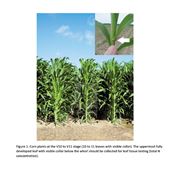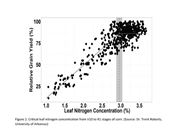Importance Of Corn Leaf Tissue Testing For Determining Pre-Tassel Nitrogen Need
DR. RASEL PARVEJ
BATON ROUGE, LOUISIANA
Corn tissue testing is one of the important tools that guides whether pre-tassel nitrogen (N) is required. To evaluate N losses due to excessive rainfall after sidedress, wait until the V10 stage (10 collar leaf stage) and take tissue samples at or after V10 stage.
Tissue sampling can be done anywhere from V10 to R1 (silking stage) stages but earlier (V10) would be better if the fields experienced water-logged conditions for several days. For tissue testing, the uppermost fully developed leaf with visible collar below the whorl (Figure 1) from 10 to 15 plants should be collected and sent immediately to the lab for total N concentration. For a large field, several composite tissue samples from the different parts of the field should be collected to better understand corn N status and follow up management. The critical corn leaf N concentration from V10 to R1 stage ranges from 2.9 to 3.1 percent (Figure 2). Leaf N concentration below 2.9 percent would be considered deficient (additional N is needed for maximizing yield) and above 3.1 percent would be sufficient (no additional N is required). However, leaf N concentration within a critical range should require a good scientific interpretation before making additional N fertilization decision based on pre-plant and sidedress N rate and application time, soil type, drainage, and water- logged conditions, rainfall amount after sidedress application, and yield goal. Take caution when collecting leaf tissue samples and interpreting N concentration because leaf N concentration can be high due to insufficient plant growth (low dilution) associated with drought, diseases, and pest infestation.
If applying pre-tassel N, the rate should be 15 to 25 percent of the total N applied i.e., roughly 40 to 60 lb N/acre. Producers can choose either dry (Urea, 46-0-0) or liquid (UAN, 32-0-0, 30-0-0-2S, or 28-0-0-5S) N source. Urea can easily be flown by airplane. UAN should be applied as surface application because high rates of UAN (without water dilution) as foliar application will result in severe foliage burn. However, producers can apply UAN through their pivot irrigation system, if available, as fertigation. Regardless of N sources, it would be better to place N fertilizer close to plant base, if possible, with a high clearance applicator using “Y-drop” to facilitate rapid uptake, minimize N losses, and avoid foliage damage.
Application before an expected rain (about 0.25-inch) or pivot irrigation is recommended to incorporate applied N that will minimize volatilization loss. Further, use N-stabilizers (urease inhibitor) to reduce volatilization loss. Experiments conducted at the LSU AgCenter showed that when urea was surface applied at late growth stages, use of N-stabilizer decreased ammonia volatilization losses by 74 percent and increased corn grain yield by 12 to 25 percent compared to uncoated urea. Overall, a producer should consider rainfall amount following sidedress N application, field conditions, crop growth, yield potential, and tissue-testing to evaluate N losses and pre-tassel N application. ∆
DR. RASEL PARVEJ: Assistant Professor, LSU AgCenter

Figure 1. Corn plants at the V10 to V11 stage (10 to 11 leaves with visible collar). The uppermost fully developed leaf
with visible collar below the whorl should be collected for leaf tissue testing (total N concentration).

Figure 2. Critical leaf nitrogen concentration from V10 to R1 stages of corn.
Source: Dr. Trent Roberts, University of Arkansas